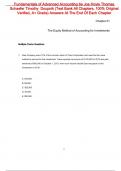Fundamentals of Advanced Accounting 6e Joe Hoyle Thomas
Schaefer Timothy Doupnik (Test Bank All Chapters, 100% Original
Verified, A+ Grade) Answers At The End Of Each Chapter
Chapter 01
The Equity Method of Accounting for Investments
Multiple Choice Questions
1. Gaw Company owns 15% of the common stock of Trace Corporation and used the fair-value
method to account for this investment. Trace reported net income of $110,000 for 2013 and paid
dividends of $60,000 on October 1, 2013. How much income should Gaw recognize on this
investment in 2013?
A. $16,500.
B. $9,000.
C. $25,500.
D. $7,500.
E. $50,000.
1-1
Copyright © 2015 McGraw-Hill Education. All rights reserved. No reproduction or distribution without the prior written consent of
McGraw-Hill Education.
,2. Yaro Company owns 30% of the common stock of Dew Co. and uses the equity method to
account for the investment. During 2013, Dew reported income of $250,000 and paid dividends of
$80,000. There is no amortization associated with the investment. During 2013, how much
income should Yaro recognize related to this investment?
A. $24,000.
B. $75,000.
C. $99,000.
D. $51,000.
E. $80,000.
3. On January 1, 2013, Pacer Company paid $1,920,000 for 60,000 shares of Lennon Co.'s voting
common stock which represents a 45% investment. No allocation to goodwill or other specific
account was made. Significant influence over Lennon was achieved by this acquisition. Lennon
distributed a dividend of $2.50 per share during 2013 and reported net income of $670,000. What
was the balance in the Investment in Lennon Co. account found in the financial records of Pacer
as of December 31, 2013?
A. $2,040,500.
B. $2,212,500.
C. $2,260,500.
D. $2,171,500.
E. $2,071,500.
1-2
Copyright © 2015 McGraw-Hill Education. All rights reserved. No reproduction or distribution without the prior written consent of
McGraw-Hill Education.
,4. A company should always use the equity method to account for an investment if:
A. It has the ability to exercise significant influence over the operating policies of the investee.
B. It owns 30% of another company's stock.
C. It has a controlling interest (more than 50%) of another company's stock.
D. The investment was made primarily to earn a return on excess cash.
E. It does not have the ability to exercise significant influence over the operating policies of the
investee.
5. On January 1, 2011, Dermot Company purchased 15% of the voting common stock of Horne
Corp. On January 1, 2013, Dermot purchased 28% of Horne's voting common stock. If Dermot
achieves significant influence with this new investment, how must Dermot account for the change
to the equity method?
A. It must use the equity method for 2013 but should make no changes in its financial statements
for 2012 and 2011.
B. It should prepare consolidated financial statements for 2013.
C. It must restate the financial statements for 2012 and 2011 as if the equity method had been
used for those two years.
D. It should record a prior period adjustment at the beginning of 2013 but should not restate the
financial statements for 2012 and 2011.
E. It must restate the financial statements for 2012 as if the equity method had been used then.
1-3
Copyright © 2015 McGraw-Hill Education. All rights reserved. No reproduction or distribution without the prior written consent of
McGraw-Hill Education.
, 6. During January 2012, Wells, Inc. acquired 30% of the outstanding common stock of Wilton Co.
for $1,400,000. This investment gave Wells the ability to exercise significant influence over
Wilton. Wilton's assets on that date were recorded at $6,400,000 with liabilities of $3,000,000.
Any excess of cost over book value of Wells' investment was attributed to unrecorded patents
having a remaining useful life of ten years.
In 2012, Wilton reported net income of $600,000. For 2013, Wilton reported net income of
$750,000. Dividends of $200,000 were paid in each of these two years. What was the reported
balance of Wells' Investment in Wilson Co. at December 31, 2013?
A. $1,609,000.
B. $1,485,000.
C. $1,685,000.
D. $1,647,000.
E. $1,054,300.
7. On January 1, 2013, Bangle Company purchased 30% of the voting common stock of Sleat Corp.
for $1,000,000. Any excess of cost over book value was assigned to goodwill. During 2013, Sleat
paid dividends of $24,000 and reported a net loss of $140,000. What is the balance in the
investment account on December 31, 2013?
A. $950,800.
B. $958,000.
C. $836,000.
D. $990,100.
E. $956,400.
1-4
Copyright © 2015 McGraw-Hill Education. All rights reserved. No reproduction or distribution without the prior written consent of
McGraw-Hill Education.




